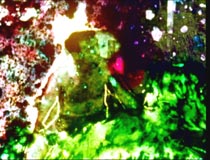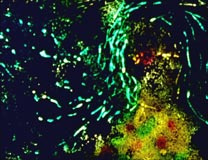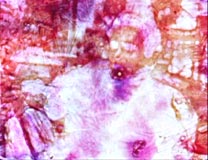Eye Myth (Stan Brakhage, 1967)
 Eye Myth, at nine seconds long, is the shortest film made by the late
avant-garde master Stan Brakhage, but painted onto its densely packed frames one
can find numerous possible meanings. One seemingly valid reading would be to
view it as a concise, but complete, visceral creation myth. After the title,
which has been etched directly into the celluloid as in most of Brakhageís
films, the first frames of Eye Myth
are pure white. Suddenly, from that blankness springs a deluge of colors and
shapes, seemingly random at first, with each frame a radical change from the
last. From that instantaneous burst of chaos form discernable patterns, and from
it surfaces, fully formed, the image of a man seated in a room. He subsides back
into the commotion, and then reemerges, walking in a city street. Never does he
become so defined that he escapes association with the flurry of colors that
surrounds him. After we understand him as a figure within that context, he,
along with the colors that seemed to sustain him, flicker and fade to black,
ending the filmís brief life cycle. In that respect, it is a self-centered
portrait, revolving its entire story around the existence of one individual, but
in its mini-narrative it reveals something inescapable about the egotism of such
myths.
Eye Myth, at nine seconds long, is the shortest film made by the late
avant-garde master Stan Brakhage, but painted onto its densely packed frames one
can find numerous possible meanings. One seemingly valid reading would be to
view it as a concise, but complete, visceral creation myth. After the title,
which has been etched directly into the celluloid as in most of Brakhageís
films, the first frames of Eye Myth
are pure white. Suddenly, from that blankness springs a deluge of colors and
shapes, seemingly random at first, with each frame a radical change from the
last. From that instantaneous burst of chaos form discernable patterns, and from
it surfaces, fully formed, the image of a man seated in a room. He subsides back
into the commotion, and then reemerges, walking in a city street. Never does he
become so defined that he escapes association with the flurry of colors that
surrounds him. After we understand him as a figure within that context, he,
along with the colors that seemed to sustain him, flicker and fade to black,
ending the filmís brief life cycle. In that respect, it is a self-centered
portrait, revolving its entire story around the existence of one individual, but
in its mini-narrative it reveals something inescapable about the egotism of such
myths.
 Perhaps a better interpretation, because
it relies less on awareness of external modes of folklore, would be to look at Eye
Mythís way of seeing as a meditation on our own. In the confusion of what
we see in the world around us, we have no choice but to create order and ascribe
meaning. When we finally get a glimpse of something we can understand (in the
case of Eye Myth, the man) we seize upon it and begin to construct a
narrative around it. In life as in the film, the things that we canít explain
become subservient to the meanings of the ones that we can, so that we might
reconcile ourselves somehow with their mysterious existence. The mode of natural
selection that occurs when we see what we choose to see of the world is at once
a defense mechanism constructed to save us from information overload and the
very definition of the personal experience that creates the self. As the title
implies, however, any semblance of total understanding of the world is a myth,
continually perpetuated by the egoís willingness to project itself on the
world around it. Nonetheless, because Brakhage embraces that personal experience
here and does not dogmatically imbue his images with a single, definitive
meaning, itís rather likely that every viewer will find their own
interpretation, whether it be one thatís profound, based entirely on the
filmís aesthetics, or essentially meaningless.
Perhaps a better interpretation, because
it relies less on awareness of external modes of folklore, would be to look at Eye
Mythís way of seeing as a meditation on our own. In the confusion of what
we see in the world around us, we have no choice but to create order and ascribe
meaning. When we finally get a glimpse of something we can understand (in the
case of Eye Myth, the man) we seize upon it and begin to construct a
narrative around it. In life as in the film, the things that we canít explain
become subservient to the meanings of the ones that we can, so that we might
reconcile ourselves somehow with their mysterious existence. The mode of natural
selection that occurs when we see what we choose to see of the world is at once
a defense mechanism constructed to save us from information overload and the
very definition of the personal experience that creates the self. As the title
implies, however, any semblance of total understanding of the world is a myth,
continually perpetuated by the egoís willingness to project itself on the
world around it. Nonetheless, because Brakhage embraces that personal experience
here and does not dogmatically imbue his images with a single, definitive
meaning, itís rather likely that every viewer will find their own
interpretation, whether it be one thatís profound, based entirely on the
filmís aesthetics, or essentially meaningless.
 The usual mode of theatrical
presentation for Eye Myth consists of
several successive viewings of the film, followed by a slowed down projection so
that the audience can begin to appreciate the density of every frame. With the
filmís release on DVD, technology finally allows one a chance to examine it at
oneís own pace. Brakhage reportedly spent about a year conceptualizing and
filming the nine second movie, but after youíve studied it, that hardly seems
surprising. Several times, it shifts visual schemes and as Brakhage deconstructs
the medium itself, asks us to deconstruct our responses. With multiple viewings,
hopefully with the viewer approaching with different states of mind, other
layers of meaning are revealed. Through familiarity, the experience of watching
the film becomes something increasingly nebulous and conversational. Because of
Brakhageís refusal to dictate meaning and his willingness to challenge the
ways we perceive, the more you put into Eye Myth, the more it has to give
you.
The usual mode of theatrical
presentation for Eye Myth consists of
several successive viewings of the film, followed by a slowed down projection so
that the audience can begin to appreciate the density of every frame. With the
filmís release on DVD, technology finally allows one a chance to examine it at
oneís own pace. Brakhage reportedly spent about a year conceptualizing and
filming the nine second movie, but after youíve studied it, that hardly seems
surprising. Several times, it shifts visual schemes and as Brakhage deconstructs
the medium itself, asks us to deconstruct our responses. With multiple viewings,
hopefully with the viewer approaching with different states of mind, other
layers of meaning are revealed. Through familiarity, the experience of watching
the film becomes something increasingly nebulous and conversational. Because of
Brakhageís refusal to dictate meaning and his willingness to challenge the
ways we perceive, the more you put into Eye Myth, the more it has to give
you.
80
06-24-03
Jeremy Heilman